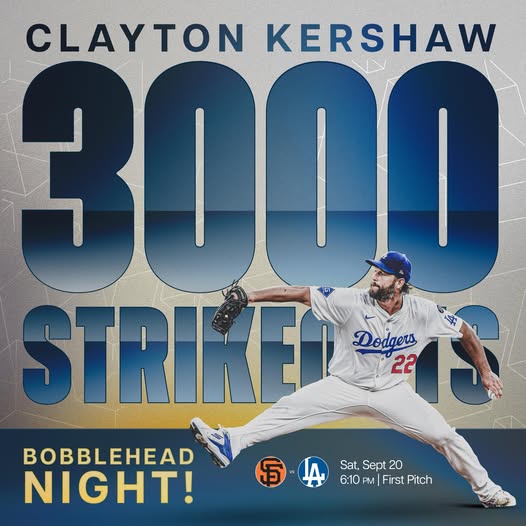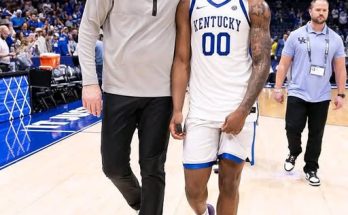In the world of baseball, few names resonate as deeply with greatness, consistency, and dominance as Clayton Kershaw. The Los Angeles Dodgers’ ace has carved a legendary path through Major League Baseball, embodying the perfect fusion of talent, hard work, and humility. With his recent achievement of 3,000 career strikeouts, the Dodgers have announced a fitting tribute: a special bobblehead night to honor one of the greatest pitchers of his generation. But beyond the promotion and the collectible figurine lies a deeper story—one of perseverance, transformation, loyalty, and undeniable excellence.
Clayton Kershaw’s career has been nothing short of remarkable. Drafted seventh overall in the 2006 MLB Draft by the Dodgers, expectations were high from the beginning. It didn’t take long for Kershaw to make good on those expectations. By 2008, he made his debut at just 20 years old, showing flashes of what would become a generational talent. Over the next several years, Kershaw evolved from a promising youngster with a wicked curveball into a dominant force atop the Dodgers’ rotation. His delivery, marked by its deceptive motion and precise control, baffled hitters. His curveball was dubbed “Public Enemy No. 1” for good reason.
As the years went by, Kershaw’s resume grew richer and more decorated. He won the National League Cy Young Award three times—in 2011, 2013, and 2014—and took home the league’s Most Valuable Player award in 2014, an almost unheard-of honor for a pitcher in the modern era. But what separated Kershaw from the rest wasn’t just the accolades. It was his consistency, his ability to dominate over a decade, and the calm demeanor with which he approached the game. While others flamed out or regressed, Kershaw adapted and endured.
His journey to 3,000 strikeouts is a testament to that endurance. Reaching 3,000 strikeouts is no small feat. Only a handful of pitchers in MLB history have reached that plateau, and even fewer have done so while spending their entire careers with one franchise. It’s an achievement that speaks to both excellence and longevity—qualities that define Kershaw’s career. Every strikeout along the way tells a story: from overpowering rookies to outwitting veterans, from playoff duels to regular-season grinds. Each pitch added another stitch to the tapestry of Kershaw’s greatness.
The Dodgers, a franchise steeped in history and rich with iconic moments, understand the magnitude of Kershaw’s accomplishment. That’s why they’ve chosen to honor him in a way that resonates with fans both young and old. On the night of the celebration, fans entering Dodger Stadium will receive a limited-edition Clayton Kershaw bobblehead, immortalizing the pitcher mid-windup—his familiar mechanics frozen in time. It’s a nod to a legend and a gift to the faithful fan base that has cheered him on from the beginning.
But the bobblehead is more than just a giveaway. It symbolizes an era, a connection between a player and a city. Los Angeles and Kershaw have become synonymous, not just because of his on-field heroics, but because of the way he’s embedded himself in the community. Through his charitable foundation, Kershaw’s Challenge, he and his wife Ellen have impacted countless lives, both domestically and abroad. His presence in L.A. is felt not just on the mound, but in schools, shelters, and hospitals. The bobblehead, then, isn’t merely a celebration of numbers—it’s a recognition of character.
What makes Kershaw’s 3,000 strikeouts even more impressive is how he got there. Unlike many power pitchers who rely almost exclusively on velocity, Kershaw has adapted as time wore on. As injuries took their toll and his fastball velocity dipped from the upper 90s to the low 90s, he recalibrated. He leaned more heavily on location, movement, and sequencing. His slider became his most reliable weapon, and his mastery of pitch tunneling kept hitters guessing. In a sport where so many careers are short-lived due to physical demands, Kershaw has managed to maintain elite performance through brain as much as brawn.
There were times along the way when doubt crept in—seasons interrupted by injury, playoff disappointments, the changing dynamics of the Dodgers roster. Yet, Kershaw never wavered. Even as younger arms like Walker Buehler, Julio Urías, and now Gavin Stone and Bobby Miller emerged, Kershaw remained the lodestar, guiding the team through his steady leadership and competitive fire. His role may have evolved—from ace to elder statesman—but his value has never diminished.
The night the Dodgers honor him will undoubtedly be filled with emotion. The roar of the crowd as Kershaw takes the mound, the video tributes showcasing highlights from his storied career, and the cheers from fans who have grown up watching him dominate—all of it will make for a powerful tribute. It’s rare for an athlete to command such widespread respect in a single city for so long. Even rarer is a player who lives up to the hype and then surpasses it, season after season, pitch after pitch.
Yet perhaps what makes Kershaw most beloved is his humility. For all the records, the awards, and the acclaim, he’s never made the moment about himself. He speaks in terms of team, often deflecting praise to catchers, coaches, and teammates. He’s quick to credit others and reluctant to bask in personal glory. That makes a celebration like this all the more meaningful—because fans know he would never ask for it. He’s earned every cheer, every standing ovation, every bobblehead.
The timing of the celebration also adds a layer of poignancy. At this stage of his career, Kershaw is very much in the twilight. Though he remains effective, the wear and tear of nearly two decades in the majors is evident. Each start could be his last at Dodger Stadium. Each milestone could be a farewell. The bobblehead night, then, might not just be a celebration of 3,000 strikeouts, but a heartfelt thank-you for a career that has brought so much joy, pride, and inspiration.
Kershaw’s legacy is already etched into the annals of baseball history. He will be a first-ballot Hall of Famer, his name forever linked with the game’s greatest pitchers. But his most lasting legacy might be the moments he created—the curveball that buckled knees, the complete games under the lights, the passionate stare into the catcher’s mitt before a pivotal pitch. For Dodgers fans, those memories are priceless. And for those lucky enough to be in attendance on bobblehead night, they’ll receive a token of that legacy—a figurine that captures a man who gave everything to the game.
In the end, celebrating Clayton Kershaw’s 3,000 strikeouts is about more than numbers. It’s about honoring a rare kind of greatness—one that endures, evolves, and elevates everyone around it. It’s about the bond between a pitcher and a city, a fan base and a franchise icon. And for one night, under the lights of Chavez Ravine, it’s about pausing to appreciate a once-in-a-generation talent whose impact goes far beyond the box score. As fans rise to their feet and wave their bobbleheads in tribute, they won’t just be cheering for strikeouts. They’ll be cheering for the heart and soul of the Los Angeles Dodgers.



